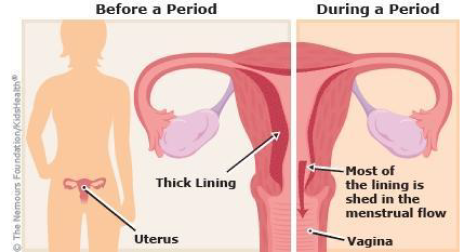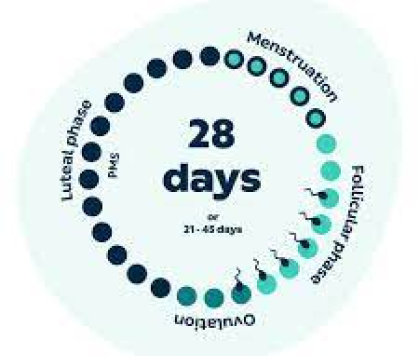Discover the wonders of the human body, from anatomy and development to sexual identity.
Now that you have the basic understanding of your reproductive system and organs including their functions, let’s take a look at some of the processes that take place in your body.
At the onset of puberty, a girl’s ovaries begin to produce and release a mature egg with each menstrual cycle. This is called ovulation. Once a girl begins to ovulate, she can become pregnant🤰. Yes, that’s it. For the boys, the testes begin to produce and release sperm. This release of sperm is what we call ejaculation. Once a boy begins to ejaculate, he can impregnate a girl.
In humans, reproduction takes place when the sperm from the male fuses with the matured egg from the fallopian tube of the female in a process referred to as fertilisation. When this happens, the fertilised egg develops into an embryo, travels to the uterus and attaches to the uterine wall. This is called implantation. The fertilised egg (foetus) continues to develop in the uterus of the female for about 9 months and then a baby is born👶. Well, that’s how you got here! Now you know better.
While it is not all sexual intercourse that leads to pregnancy, adolescence is a time for education and growing up. It is not for the right time to become a mummy or daddy!
Now, let’s talk about the menstrual cycle, shall we? The menstrual cycle is like stepping into a world where your body is about to show its natural superpowers. It’s a sign that your body is working just right. Think of your menstrual cycle like the monthly reboot of your body’s system – it’s preparing for a potential pregnancy, and when that doesn’t happen, it restarts. It’s more than just your period; it’s the whole cycle from Day 1 of bleeding to Day 1 of the next time you bleed🩸.

Grab a calendar or download an app🤳. Mark the first day of your period as Day 1. Count each day until your next period starts. That’s the length of your cycle. Most people have a cycle between 21 and 35 days, but when you’re just starting, it can be like Nollywood plot twists – unpredictable.
Calculating your menstrual cycle involves tracking the start dates of menstruation over several months. Here’s a simple step-by-step guide:
Mark the Start Date: On a calendar, mark the first day of your period (the first day of full bleeding) as Day 1. This is the start of your menstrual cycle. Count the Days: Count each day until the next period begins. The day before the next period is the last day of your cycle. Track for a Few Months: Do this for about 3 to 6 months to get an average cycle length.
Calculate the Average: Add up the total number of days in each cycle and divide by the number of cycles you’ve tracked. Remember, cycles can vary from 21 to 35 days. Knowing your average cycle length helps predict when your next period will be and identify any irregularities that may need medical attention.
The menstrual cycle usually occurs in phases. Don’t worry about all the names, Just understand the process.
Now that you understand the process of menstruation, you need to know how to maintain good hygiene during your period. Choose your menstrual hygiene products: pads, tampons, or menstrual cups. Use products that are suitable for you and appropriate for your period flow; and are also available and affordable for you. The average female uses an average of 144 pieces of pad in a year.
PMS means Premenstrual Syndrome. There are lots of changes that come with puberty and can be broadly classified as physical, social and emotional changes.
It’s time to kick out the stigma. Periods are normal, and talking about them should be too. Have questions? Ask your parents, an older sibling, or a teacher👨🏫. No myths, no whispers – just straight talk.
If your periods are super heavy, super painful, or more irregular than NEPA’s light schedule, it’s time to see a doctor👨⚕️. There’s no need to be shy; it’s their job to help you out. Remember, managing your menstrual health is about staying informed, prepared, and comfortable. So, let’s keep it real and handle it like the bosses we are!
So you might be wondering for how long you will have menstrual cycles – no cause for worry as it is usually for a period of time usually from the onset of puberty till mid-life. Most girls begin menstruation between the ages of 9-13 years and the first menstruation is referred to as menarche. At mid-life typically from the mid to late forties, the hormonal level decreases, stops releasing eggs and menstruation stops. This is referred to as menopause and it also signals the end of fertility. It varies for each woman and differs in setting.

How to Know if you’re Pregnant?
Early signs of pregnancy differ for all females and between pregnancies. The most common symptom is to miss a regular menstrual period, other symptoms include nausea🤢, dizziness, frequent urination, tiredness, fatigue, pregnancy test.
What to do if Pregnant
1. Avoid alcohol, drugs, and unnecessary medications.
2. Take the recommended vitamins and mineral supplements (especially iron and folic acid).
3. Visit an antenatal-care provider to check your health status and the health and development of the foetus. You will also learn how to take care of your pregnancy and about childbirth.
Unplanned Pregnancy
This is a pregnancy that occurs at a time you are not ready for it. Early sexual initiation among adolescents is the most common cause of teenage pregnancy🤰.
Causes of Unplanned Pregnancy
1. Incorrect use of contraceptives
2. Poor knowledge of contraceptive methods and lack of comprehensive sexuality education for females and males
3. Rape and other forms of sexual violence
4. Having sex under the influence of drugs💊 and alcohol
You can prevent unplanned pregnancy by practising sexual abstinence, having knowledge and use of contraceptives. It is also important to have information about Sexual Health and RIghts.
We use cookies to improve your experience on our site. By using our site, you consent to cookies.
Manage your cookie preferences below:
Essential cookies enable basic functions and are necessary for the proper function of the website.
These cookies are needed for adding comments on this website.
Statistics cookies collect information anonymously. This information helps us understand how visitors use our website.
Google Analytics is a powerful tool that tracks and analyzes website traffic for informed marketing decisions.
Service URL: policies.google.com (opens in a new window)